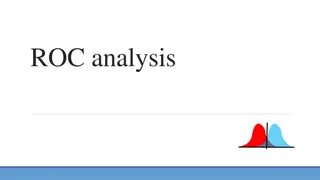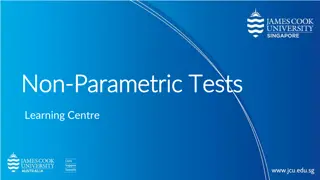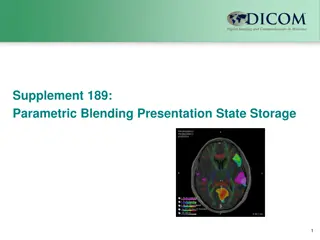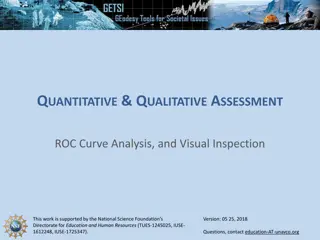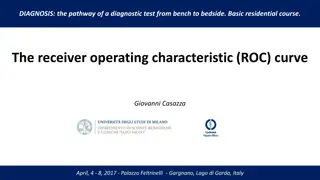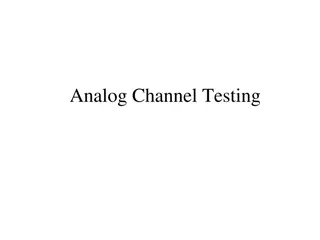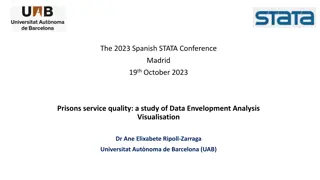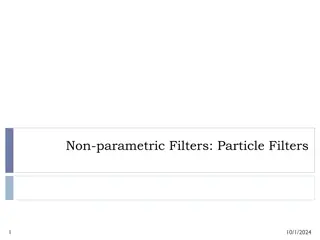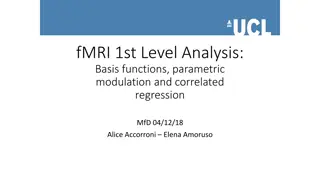Understanding Non-Parametric ROC Analysis in Diagnostic Testing
Non-parametric ROC analysis is a crucial method in diagnostic testing to determine the performance of binary classification tests in distinguishing between diseased and healthy subjects. This analysis involves evaluating sensitivity, specificity, positive predictive value, and negative predictive value to assess test accuracy and effectiveness. By understanding these statistical measures, healthcare professionals can make informed decisions about patient outcomes and treatment strategies.
Download Presentation

Please find below an Image/Link to download the presentation.
The content on the website is provided AS IS for your information and personal use only. It may not be sold, licensed, or shared on other websites without obtaining consent from the author. Download presentation by click this link. If you encounter any issues during the download, it is possible that the publisher has removed the file from their server.
E N D
Presentation Transcript
Non-parametric ROC Analysis Nina Gunnes March 18, 2021 03/18/2021 Spring 2021 - Lecture 5 1
Diagnostic test Binary classification test used in medical testing Determining whether a subject has a disease or not Classifying subjects into two groups based on a classification rule Subjects predicted to belong to one of the classes Distinguishing between perfect and imperfect classification Errors (i.e., false results) appearing in imperfect classification False positive (FP): disease detected when it is not present False negative (FN): disease not detected when it is present 03/18/2021 Spring 2021 - Lecture 5 2
Diagnostic test, cont. True disease status Test result Diseased Healthy Total TP: ? FP: ? ? + ? Positive FN: ? TN: ? ? + ? Negative ? + ? ? + ? ? + ? + ? + ? Total 03/18/2021 Spring 2021 - Lecture 5 3
Sensitivity Statistical measure of the performance of a diagnostic test Ability to correctly identify diseased subjects Also known as the true-positive rate (TPR) Proportion of diseased subjects with a positive test ??? = ? positive test|diseased = Preferably as high as possible Competing against specificity ? ? + ? 03/18/2021 Spring 2021 - Lecture 5 4
Specificity Statistical measure of the performance of a diagnostic test Ability to correctly identify healthy subjects Also known as the true-negative rate (TNR) Proportion of healthy subjects with a negative test ??? = ? negative test|healthy = Preferably as high as possible Competing against sensitivity ? ? + ? 03/18/2021 Spring 2021 - Lecture 5 5
Positive predictive value (PPV) Statistical measure of the performance of a diagnostic test Proportion of subjects with a positive test who are truly diseased ??? = ? diseased|positive test = ???: true-positive rate (i.e., sensitivity) ???: true-negative rate (i.e., specificity) ??: prevalence Depending on the prevalence ??? ?? ? ??? ??+ 1 ??? 1 ??= ?+? 03/18/2021 Spring 2021 - Lecture 5 6
Negative predictive value (NPV) Statistical measure of the performance of a diagnostic test Proportion of subjects with a negative test who are truly healthy ??? = ? healthy|negative test = ???: true-positive rate (i.e., sensitivity) ???: true-negative rate (i.e., specificity) ??: prevalence Depending on the prevalence ??? 1 ?? ? ??? 1 ?? + 1 ??? ??= ?+? 03/18/2021 Spring 2021 - Lecture 5 7
Confusion matrix "File:Preventive Medicine - Statistics Sensitivity TPR, Specificity TNR, PPV, NPV, FDR, FOR, ACCuracy, Likelihood Ratio, Diagnostic Odds Ratio 2 Final wiki.png" by Lavender888000 is licensed with CC BY-SA 4.0. To view a copy of this license, visit https://creativecommons.org/licenses/by-sa/4.0 03/18/2021 Spring 2021 - Lecture 5 8
HIV test (Aalen et al., 2006) Registering antibodies against HIV Defining two events ?: positive test result ?: subject infected Defining sensitivity (i.e., probability of positive test when infected) ? ?|? = 0.98 ? ?|? = 0.02 Defining specificity (i.e., probability of negative test when uninfected) ? ?| ? = 0.998 ? ?| ? = 0.002 03/18/2021 Spring 2021 - Lecture 5 9
HIV test (Aalen et al., 2006), cont. Defining prevalence (i.e., probability of infection) ? ? = 0.001 ? ? = 0.999 Calculating positive predictive value (using Bayes theorem) ? ?|? = ? ?|? ? ? +? ?| ? ? ?= Calculating negative predictive value (using Bayes theorem) ? ?| ? = ? ?| ? ? ? +? Predictive values depending on prevalence ? ?|? ? ? 0.98 0.001 0.98 0.001+0.002 0.999= 0.33 ?| ? ? ? ? 0.998 0.999 ?|? ? ?= 0.998 0.999+0.02 0.001= 1.00 03/18/2021 Spring 2021 - Lecture 5 10
HIV test (Aalen et al., 2006), cont. 03/18/2021 Spring 2021 - Lecture 5 11
Receiver operating characteristic (ROC) Quantifying the accuracy of a diagnostic test Using the ROC curve Graph of sensitivity versus 1 - specificity of the diagnostic test Interpreted as a two-stage process Control distribution of classifier estimated Classifier standardized to 1 - percentile value (FPR) using control distribution ROC curve estimated as case distribution of standardized classifier values 03/18/2021 Spring 2021 - Lecture 5 12
Area under the ROC curve (AUC) Summarizing the global performance of a diagnostic test Interpreted as a probability Test result greater for a diseased subject than for a healthy subject The greater the AUC, the better the global performance of the test 03/18/2021 Spring 2021 - Lecture 5 13
Data example Stata Base Reference Manual, Release 15 Example 1 on page 2435 ( Nonparametric ROC analysis section) Data from a study by Hanley and McNeil (1982) Patients classified by a reviewer Tomographic images from 109 patients with neurological problems Patients grouped according to disease status 0: normal (58 normal patients) 1: abnormal (51 abnormal patients) 03/18/2021 Spring 2021 - Lecture 5 14
Data example, cont. Patients classified using a 5-point rating scale 1: definitely normal (36 patients) 2: probably normal (8 patients) 3: questionable (8 patients) 4: probably abnormal (22 patients) 5: definitely abnormal (35 patients) 03/18/2021 Spring 2021 - Lecture 5 15
In Stata: Data load Using webuse command Data available on Stata s website https://www.stata- press.com/data/ Loading data set over the web Name: hanley 03/18/2021 Spring 2021 - Lecture 5 16
In Stata: Data inspection Using describe command Describing data in memory Summary of the data set 03/18/2021 Spring 2021 - Lecture 5 17
In Stata: Data inspection, cont. Using list command Listing values of variables 03/18/2021 Spring 2021 - Lecture 5 18
In Stata: Data inspection, cont. Using tabulate command Tabulating two variables Variable 1: rating Variable 2: disease 03/18/2021 Spring 2021 - Lecture 5 19
In Stata: Non-parametric ROC analysis Using roctab command Performing ROC analysis Reference variable: disease Rating variable: rating 03/18/2021 Spring 2021 - Lecture 5 20
In Stata: Non-parametric ROC analysis, cont. 03/18/2021 Spring 2021 - Lecture 5 21
References Aalen OO, Frigessi A, Moger TA, Scheel I, Skovlund E, Veier d MB. Statistiske metoder i medisin og helsefag. Oslo: Gyldendal akademisk; 2006. Hanley JA, McNeil BJ. The meaning and use of the area under a receiver operating characteristic (ROC) curve. Radiology. 1982;143(1):29 36. doi:10.1148/radiology.143.1.7063747 Laake P, Hjart ker A, Thelle DS, Veier d MB. Epidemiologiske og kliniske forskningsmetoder. Oslo: Gyldendal akademisk; 2007. https://www.med.uio.no/imb/forskning/publikasjoner/boker/2007/epidemiolgiske-kliniske-forskningsmetoder.html. StataCorp. 2017. Stata 15 Base Reference Manual. College Station, TX: Stata Press. Wikipedia contributors. (2020, December 5). Binary classification. In Wikipedia, The Free Encyclopedia. Retrieved 17:02, March 17, 2021, from https://en.wikipedia.org/w/index.php?title=Binary_classification&oldid=992413365 Wikipedia contributors. (2021, March 16). Classification rule. In Wikipedia, The Free Encyclopedia. Retrieved 17:04, March 17, 2021, from https://en.wikipedia.org/w/index.php?title=Classification_rule&oldid=1012476610 Wikipedia contributors. (2021, February 27). Confusion matrix. In Wikipedia, The Free Encyclopedia. Retrieved 17:04, March 17, 2021, from https://en.wikipedia.org/w/index.php?title=Confusion_matrix&oldid=1009198831 Wikipedia contributors. (2021, March 14). Sensitivity and specificity. In Wikipedia, The Free Encyclopedia. Retrieved 17:05, March 17, 2021, from https://en.wikipedia.org/w/index.php?title=Sensitivity_and_specificity&oldid=1011999716 03/18/2021 Spring 2021 - Lecture 5 22


